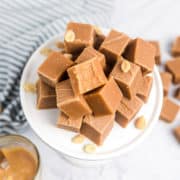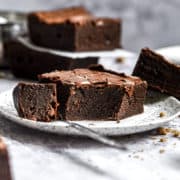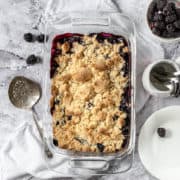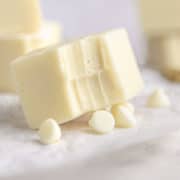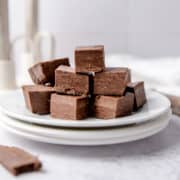Watermelon has to be one of the most delicious fruits and it's great in all kinds of recipes from a fresh fruit salad to ice cream sundaes. A slice of watermelon also makes a tasty treat, especially on a hot summer day if you want to cool down.

Jump to:
You can buy a whole watermelon, a half or quarter, or even a watermelon that's been cut into slices. Whole watermelons can be very heavy and do not always fit in the refrigerator, which is why it's great you can purchase this juicy fruit in smaller portions.
I love to serve watermelon Jell-O cupcakes with some fresh watermelon on the side. After all, there's no such thing as too much watermelon - it's just too good!
What is Watermelon?
Watermelon (Citrullus Vulgaris) is a fruit with a very high water content - around 91% water in fact. The fruit is native to Africa and was a great water source in desert situations. Watermelons were grown in India and Egypt as long ago as 2500 BC, as shown in hieroglyphics.
This popular fruit can be eaten fresh, frozen, and used in recipes such as smoothies, or juiced. A watermelon contains Vitamins A, B5, and C, plus copper and potassium. The fruit is typically chilled and then cut into slices or watermelon cubes and enjoyed as a snack or dessert. Oh, and if you've never enjoyed watermelon with feta cheese, you must try it - you're missing out!
The sweet flesh of juicy watermelon is great for melon cups and mixed fruit cups, and in the South, pickled watermelon rind is a popular treat. The hollowed-out, green rind can be carved into a basket for holding a fruit salad.
Watermelons are at their peak between mid-June and the end of August but can be found year-round at the grocery store or farmers' market. Perhaps you want to try growing your own but bear in mind this would take up a lot of space in the backyard.
How to Choose a Juicy Watermelon
If you are buying a whole one, there are several easy ways to tell how ripe it is. Look for an uncut watermelon that is dark green, firm, and symmetrical with a uniform shape. It should be dull, not shiny since shine can indicate under-ripeness. Tap it and see whether it makes a deep hollow sound or sounds dull. That deep, full sound is what you want.
Check there are no cuts, bruises, or bumps on the melon. Also, hold it to check how much it weighs. A heavy watermelon is a ripe watermelon because its weight means it's very juicy.
Look underneath the melon and you should see a "field spot" which is a yellow spot that is the part of the melon in contact with the ground while it ripened in the sun. If there is a white field spot or no field spot on the bottom of the rind, this likely means the fruit was picked before the ripening process was complete. The darker colored the field spot, the better the melon should taste.
If you're buying cut or sliced melon, make sure it's in a sealed container and avoid fruit with more than just a few white seeds or white streaks, as well as any with dried-out-looking flesh because those aren't fresh anymore.
Cut melon is fine if you only want half of the watermelon or if you don't have the refrigerator space for a huge whole fruit, so long as it's been properly packaged and stored and looks bright red and juicy.

How to Store Watermelon
If you're looking for whole, uncut fruit, you will want to choose a good watermelon because they are huge and you probably won't eat the whole thing at once. This means knowing how to store watermelon is important so you can prolong its shelf life.
- The easiest way and best way to keep a whole melon fresh is to keep it uncut in the refrigerator, where it should be fine for a week.
- Don't keep a watermelon at any temperature under 40°F though, because chilling harms the fruit and has a negative impact
- If you have a slightly under-ripe melon, keep it at room temperature for 2 days, out of direct sunlight, and then refrigerate it.
- Sliced or chopped watermelon pieces should be refrigerated in an airtight container, and used within 4 days.
- Once you have cut a watermelon, wrap the cut side in plastic wrap to stop it from drying out.
You can also freeze watermelon chunks for up to 8 months. Remove the rind as well as the seeds, and then chop it up with a sharp knife or use a melon baller. Arrange the pieces in a single layer on a baking sheet lined with parchment paper, then transfer them into a freezer bag.
When thawed it will be a little mushy, but the delicious fruit is fine for use in popsicles, juices, and smoothies.
You can also freeze watermelon juice by following these simple steps. Blend watermelon chunks in the blender, then freeze it in an airtight container with an inch or two of air at the top to allow for expansion. Use the juice within 2 months.
How to Tell if Watermelon Is Bad
Spoiled watermelon might have dark-colored patches or mold on the outside, which can be white, black, or green. The flesh might be dry and gritty because the flesh starts to shrivel when this fruit is going bad. A slimy or mushy flesh texture is another indicator of spoilage.
A fresh watermelon should smell sweet and have a fresh flavor, while a rotten one is more likely to smell sour or tangy and taste bad.
Common Questions
The brown or black seeds are safe to eat and they are a great way to get extra protein, essential fatty acids, and minerals. These seeds taste a little like sunflower seeds but aren't so nutty. You can roast them or sprout them and then sprinkle them on smoothies, toss them with a salad, or munch on them as a snack. Some varieties of watermelons don't have any seeds, so whether you opt for a regular or seedless watermelon is up to you. But don't waste the seeds!
The sheer size of whole melons can be daunting but it isn't difficult to chop or slice them up. Because watermelons release juice when cut, the best method to keep all that juice off your countertop is to put the cutting board inside a tray to catch any drips. Find your largest cook's knife and make sure it's sharp.
Cut through the center of the fruit and then cut it into thin wedges. You will see the seeds grow in seams and, when you identify their growth pattern, you can flick them out as you go. If you want to make melon balls, cut through the center of the fruit and then use a melon baller to scoop out melon balls.

Interesting Facts
- Watermelons are often grown in glass boxes in Japan to make them cube-shaped. The flat sides mean they can be stacked which saves space.
- More watermelons are grown in China than in any other country.
- Red flesh is the most common in watermelons, but some watermelon varieties have white, green, orange, or yellow flesh instead.
- Some watermelon varieties need around 130 warm days before they are fully ripe.
Once you know how to select the best fruit as well as how to store watermelons, you will be able to indulge your sweet tooth whenever you like with this fat- and cholesterol-free, healthy fruit. Watermelon not only makes a delicious snack, but is a worthy addition to everything from cupcakes to fruit salads and sundaes, and even salad recipes.





